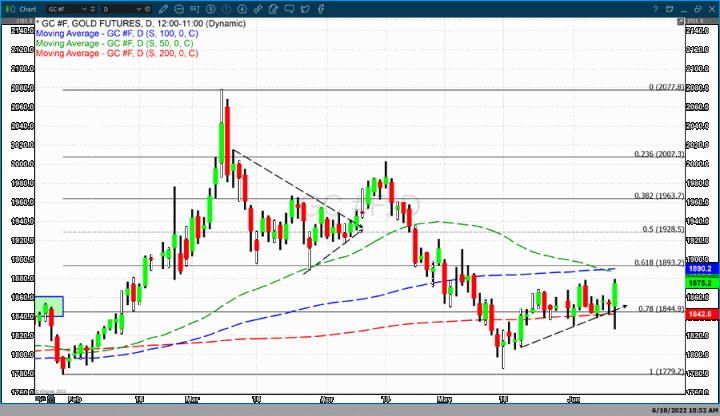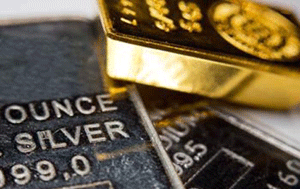
Gold suffers amid solid gains in USDX, steep rise in U.S. Treasury yields
Gold and silver prices are solidly lower in midday U.S. trading Monday, pressured by a U.S. dollar index that is solidly higher and trading near a 20-year high, and by sharply rising U.S. Treasury yields that are at multi-year highs. Gold prices did hit a five-week high overnight but those gains could not be held. August gold futures were last down $41.30 at $1,833.80. July Comex silver futures were last down $0.681 at $21.25 an ounce.
Global stock markets were mostly lower overnight. U.S. stock indexes are sharply lower at midday and hit new for-the-move lows. The Russia-Ukraine war and its economic implications, and problematic price inflation are weighing heavily on trader and investor sentiment to start the trading week. Add to that mix Covid lockdowns on the rise in China, the world’s second-largest economy and a major supplier of products around the globe. Don’t be surprised to see gold and silver bulls buy this dip amid the keener anxiety in the marketplace early this week.
The key outside markets today see Nymex crude oil prices firmer and trading around $121.50 a barrel. The U.S. dollar index is solidly higher and near a 20-year high. The yield on the 10-year U.S. Treasury note is fetching around 3.4%–the highest level in 14 years.
Crypto currencies are under strong selling pressure again to start the trading week.
The data point of the week is the Federal Reserve’s FOMC meeting that begins on Tuesday morning and ends Wednesday afternoon with a statement. The Fed is expected to raise U.S. interest rates by at least 0.5%. Fed Chairman Jerome Powell will hold a press conference after the FOMC meeting concludes Wednesday afternoon.
 Entire financial system is 'a black hole,' crypto will become the dominant force – Garry Kasparov
Entire financial system is 'a black hole,' crypto will become the dominant force – Garry Kasparov
Also to be monitored closely will be Tuesday’s U.S. producer price index report for May, which is seen up 0.8% from April and compares to April’s reading of up 0.5% from March.
There wase no major U.S. economic data released Monday.
.gif)
Technically, the August gold futures bears have the overall near-term technical advantage and regained power today. Bulls’ next upside price objective is to produce a close in June futures above solid resistance at the June high of $1,878.60. Bears' next near-term downside price objective is pushing futures prices below solid technical support at $1,800.00. First resistance is seen at $1,850.00 and then at $1,878.50. First support is seen at today’s low of $1,824.70 and then at $1,815.00. Wyckoff's Market Rating: 3.0
.gif)
July silver futures bears have the solid overall near-term technical advantage. Silver bulls' next upside price objective is closing prices above solid technical resistance at $23.00 an ounce. The next downside price objective for the bears is closing prices below solid support at the May low of $20.42. First resistance is seen at $22.00 and then at $22.25. Next support is seen at today’s low of $20.91 and then at $20.42. Wyckoff's Market Rating: 2.0.
By Jim Wyckoff
For Kitco News
Time to buy Gold and Silver on the dips
Tim Moseley




 Gold sees record bullish sentiment among European retail investors – Spectrum Markets
Gold sees record bullish sentiment among European retail investors – Spectrum Markets




(1).png) Gold market is waiting for next week's Fed meeting – StoneX's O'Connell
Gold market is waiting for next week's Fed meeting – StoneX's O'Connell.gif)
.gif)

.png) Gold price remains chained to $1,850 as OECD lowers growth forecasts
Gold price remains chained to $1,850 as OECD lowers growth forecasts



 Emerging market central banks represent new demand for gold as they de-dollarize – Société Générale
Emerging market central banks represent new demand for gold as they de-dollarize – Société Générale.gif)
.gif)

 Is global 'slavery' coming? Gold guards against 'total control' – Bob Moriarty
Is global 'slavery' coming? Gold guards against 'total control' – Bob Moriarty
.gif)
 Tennessee removes sales tax on gold and silver, only eight states to go
Tennessee removes sales tax on gold and silver, only eight states to go